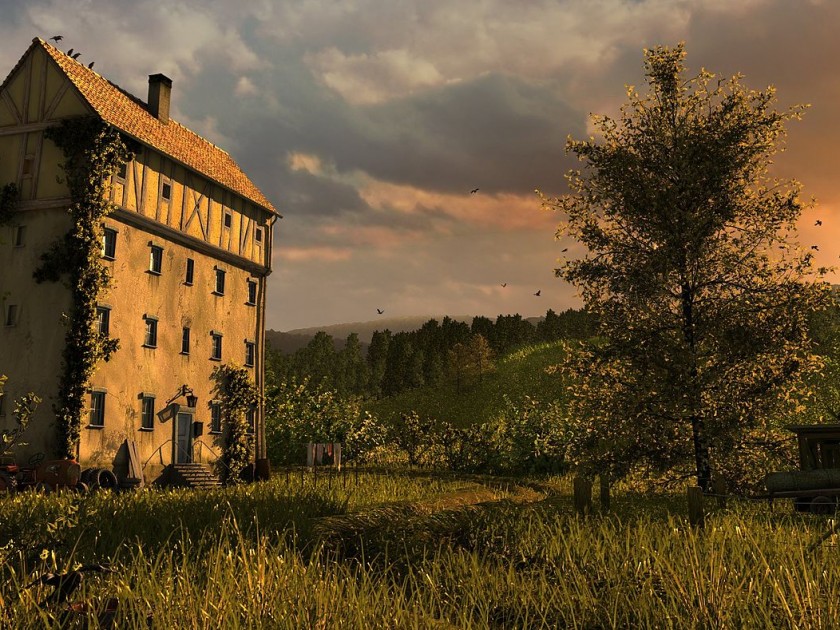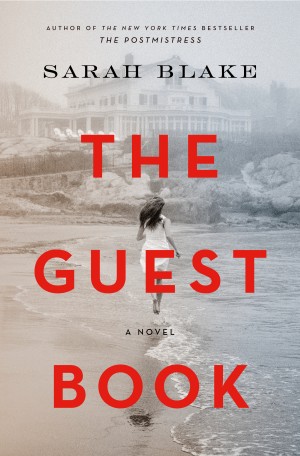
Image by Michael Otto
How sweet tobe a cloud!, Pooh exclaimed on the poster above my head, holding the end of a blue balloon and floating on the paper air every summer night as I fell asleep — the pink letters running one into the other in a bubble graphic font from the 1960s.
Though that poster disappeared in the eighties, the room and the wall remain in the summerhouse where the third and fourth generations of my family still return. And now, standing on the threshold of that room nearly sixty years later, the wall recalls the poster with its rusted metal tacks as well as the last of the summer evening light stretching through the window, the distant voices of grownups just sitting down to dinner — and my six-year-old confusion staring up at the inscrutable line: what was a tobe?
I hold that childhood image in my head, just as I can conjure the exact twining of the boats and barns on the wallpaper in the front hallway, long since papered over, but carrying with them the memory of the decorating battle between my mother and my aunt; the field of valor moving in the next summer to the contested color of the upholstery on the wingback chairs in the front room. I can tell you what remained on the mantelpiece, and what was moved off; I could describe to you the wooden bowl of nuts at my grandfather’s elbow at cocktails, and the round canvas bag my grandmother’s keys and glasses remained in on a hook by the back door. My family spoke through the dumb language of things in the rooms of our house, far more than they did themselves. So I learned early on to lean low and listen to the silence of a place.
My family spoke through the dumb language of things in the rooms of our house, far more than they did themselves. So I learned early on to lean low and listen to the silence of a place.
Houses hold stories in that silence; and when you listen, they tell them.
That silence undergirds Freud’s theory of the uncanny, the unheimlich, literally unhomelike, linking the familiar to the strange. The house holds all the layers of a self, past and present, and the return to that place forces a look into the mirror the house holds up, a confrontation with who you were the last time you crossed that threshold — whether it was this morning or last month, or last year. In the rooms of your life, you are the ghost in the mirror, the face remembered, the phrase uttered and pushed down — all held by the four walls you pass through.
As such, some of my favorite fictions are those of memory and the windy, haunting silences around what is “forgotten.” Frequently, these are stories with houses at their narrative center, working almost as if another character — the source of what goes unsaid, and often, what is most true.
When I began my third novel, The Guest Book, I wanted to write a book that entered the conversation about self, place, and memory that I had seen in other works. The following four works by Charlotte Perkins Gilman, Virginia Woolf, James Baldwin, and Nicole Krauss taught me how to think about the walls around us all and what these walls are saying.
The Guest Book chronicles three generations of the Milton family, an old money family that has come to the end of its money, but not its place — an island off the coast of Maine — or its sense of power. It moves back and forth between the 1930s, the 1950s, and the present in Manhattan and on their island, as the consequences of a single moment from a night in 1936 pass through generations, untold until the place itself demands a reckoning. It’s about confronting the history inside us — entwining a family’s untold secrets with this country’s half-told history of racism and antisemitism — the pasts we carry and blindly pass along.
Charlotte Perkins Gilman’s short story, The Yellow Wallpaper (1892) narrates one woman’s descent into madness over the course of thirty swift pages. Prescribed bed rest after a difficult childbirth, the woman is sent to “recover” in a room at the top of the house; a room she comes to realize was once the nursery. The wallpaper begins to take on the contours of her tortured and devolving psyche, the exterior expression of her interior state. It is a brilliant early feminist fiction that addresses the crucible between madness and the constraint of a woman’s body, and the imposition of silence on a woman’s mind. Here, along with Bertha Mason raging at the top of Rochester’s house in Jane Eyre, is the paradigmatic madwoman in the attic. The last sentence is one of the single most horrific endings in all of nineteenth century literature.
Virginia Woolf’s To The Lighthouse (1927) is the novel I return to again and again. Not only were hers the sentences that taught me the most, but this novel of two long days in the life of the Ramsay family at their summer house, separated by years and the Great War, show again and again how the passage of time (an afternoon, a day, a decade) is best understood by the stillness of unused objects, empty rooms, a house holding time until the family’s return. The day passes through the minds of Mr. and Mrs. Ramsay, their children, the artist Lily Briscoe, and assorted colleagues of Mr. Ramsay: a brilliant poet, a hapless philosopher. Nothing and everything happens, as is true of the best summer days. They turn off the light on the first day. And then, in the middle section: Time Passes. This is one of the most spectacular meditations on the beauty and intensity of still-life, a room covered in dust clothes, the flies trapped in windowsills, and how that still-life somehow amplifies human life most fully. When the family, much changed by the passage of time, returns the second day ten years later, they find the house unchanged. Here is the novel of a house that holds its people, the beating heart at the center of its characters, and it works like the lighthouse’s sweep, guiding us in across time and space to the final satisfying stroke of Lily Briscoe’s brush.
In James Baldwin’s second novel, Giovanni’s Room (1956) David, the narrator, tries to break from the rigid expectations of 1950s white American manhood by moving to France. Tragically, he finds that the country, our upbringing, our culture is hard to leave behind. Beginning with one of the great first lines — “I stand at the window of this great house in the south of France as night falls, the night which is leading me to the most terrible morning of my life”—the novel proceeds backward in an accounting, a reckoning for what brings him to that window. And what brings him there is love. The love that David has found in the room in Paris, Giovanni’s room — the room where Giovanni, a bartender, lives. It is a room that works like a hothouse nursery, forcing love to bloom, and obliterating for a time, the rest of the world outside the room. In that room David both comes to find and lose himself, and through his eyes we see the immense power and the limits of love.
Finally, and in some ways the obverse of all the others, Nicole Krauss’s beautiful and intricate novel Great House asks what remains when the physical house does not. What can held memory and unspoken story look like when the house is lost? The story is unhoused, as it were, and displaced into a desk, with many drawers, that binds three plot lines and their characters together; a woman writer in New York who has written on the desk she inherited from a Chilean poet; a man in London who discovers a secret lock of hair as his wife is dying; an antique dealer trying to recreate his father’s study from 1944, destroyed by the Nazis. In some senses this is the novel where the ghost of the house each of these characters is missing renders another house: the house of loss. It is a brilliant meditation on what we pull around us to write, to live, and to recreate the memories that make us, tell us who we are, reminding us that we are here.
Sarah Blake is the author of the novels Grange House, The Guest Books, and the internationally best-selling The Postmistress; a chapbook of poems, Full Turn; and Runaway Girls, an artist book in collaboration with the artist Robin Kahn. She lives in Washington D.C. with her husband, the poet Joshua Weiner, and their two sons.



